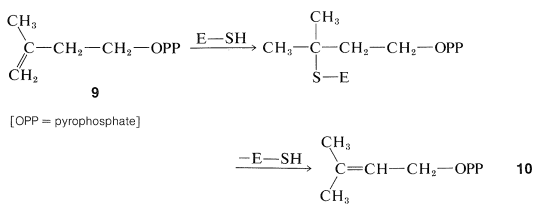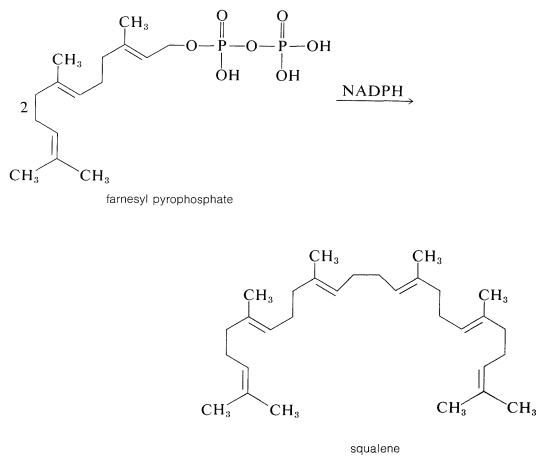
Terpene Biosynthesis
 المؤلف:
LibreTexts project
المؤلف:
LibreTexts project
 المصدر:
........
المصدر:
........
 الجزء والصفحة:
........
الجزء والصفحة:
........
 18-12-2021
18-12-2021
 2711
2711
Terpene Biosynthesis
The biosynthesis of terpenes clearly follows a somewhat different course from fatty acids in that branched-chain compounds are formed. One way that this can come about is for 2-oxobutanoyl coenzyme A to undergo an aldol addition at the keto carbonyl group with the ethanoyl coenzyme A to give the 3-methyl-3-hydroxypentanedioic acid derivative, 88:

The next step is reduction of one of the carboxyl groups of 88 to give mevalonic acid:

This substance has been shown by tracer studies to be an efficient precursor of terpenes and steroids. Mevalonic acid has six carbon atoms, whereas the isoprene unit has only five. Therefore, if mevalonic acid is the precursor of isoprene units, it must lose one carbon atom at some stage. Synthesis of mevalonic acid labeled at the carboxyl group with C14C14, and use of this material as a starting material for production of cholesterol, gives unlabeled cholesterol. Therefore, the carboxyl carbon is the one that is lost:

Formation of the "biological isoprene unit" from mevalonic acid has been shown to proceed by stepwise phosphorylation of both alcohol groups, then elimination and decarboxylation to yield 3-methyl-3-butenyl pyrophosphate, 9 (often called Δ3-isopentenyl pyrophosphate):

The coupling of the five-carbon units, 9, to give isoprenoid compounds has been suggested to proceed by the following steps. First, isomerization of the double bond is effected by an enzyme (E) carrying an SH group:

The ester, 10, then becomes connected to the double bond of a molecule of 99, probably in an enzyme-induced carbocation type of polymerization :

The product of the combination of two units of the pyrophosphate, 9, through this sequence is geranyl pyrophosphate if, as shown, the proton is lost to give a trans double bond. Formation of a cis double bond would give neryl pyrophosphate .
Continuation of the head-to-tail addition of five-carbon units to geranyl (or neryl) pyrophosphate can proceed in the same way to farnesyl pyrophosphate and so to gutta-percha (or natural rubber). At some stage, a new process must be involved because, although many isoprenoid compounds are head-to-tail type polymers of isoprene, others, such as squalene, lycopene, and β- and γ-carotene (Table 30-1), are formed differently. Squalene, for example, has a structure formed from head-to-head reductive coupling of two farnesyl pyrophosphates:

Since squalene can be produced from farnesyl pyrophosphate with NADPHNADPH and a suitable enzyme system, the general features of the above scheme for terpene biosynthesis are well supported by experiment.In summary, the sequence from ethanoate to squalene has been traced as
ethanoyl coenzyme A→mevalonic acid→isopentenyl pyrophosphate→farnesyl pyrophosphate→ squalene (30.5.4)
 الاكثر قراءة في كيمياء الاغذية والنواتج الطبيعية
الاكثر قراءة في كيمياء الاغذية والنواتج الطبيعية
 اخر الاخبار
اخر الاخبار
اخبار العتبة العباسية المقدسة


